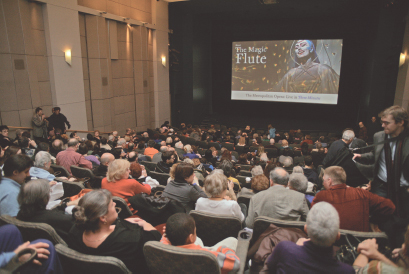Printed Page 217
CONVERGING MEDIA
Case Study

Movie Theaters and Live Exhibition
Adaptation or extinction. This Darwinian law has helped the business of movie exhibition survive into the twenty-first century. Since the arrival of the nickelodeon, the first permanent locations devoted to screening motion pictures, the exhibition branch has witnessed several profound transformations, from the development of drive-ins in the 1950s to the proliferation of multiplex screens in the 1970s and 1980s. As home viewing becomes an increasingly viable option, movie theaters are still on the lookout for opportunities to fill seats, especially on weeknights when business is slow.
Media convergence has provided just such an opportunity. In 2011, the transition to digital cinema reached what industry analysts consider a tipping point. With more than sixty thousand screens converted to digital projection technology (roughly half the exhibition facilities worldwide), movie exhibition is taking the next step in its technological evolution: the addition of live programming. Until recently, the use of theaters for the presentation of live events was limited, but not unheard of. According to legend, the Amos ‘n’ Andy radio show was so popular in the 1930s that many theaters halted their screenings for fifteen minutes to play the program over loudspeakers to the gathered audience.1 But until recently, television and radio have been the media devoted to the presentation of live events.
The repurposing of movie theaters, enabled by the conversion to digital projection, began as early as 2002, but did not attract national attention until December 2006 when National CineMedia’s programming division, NCM Fathom, presented The Magic Flute, the first installment of its Metropolitan Opera—Live in HD series.2 Fathom now boasts a network of five hundred screens; Cinedigm, another player in this fledgling field, specializes in distributing live 3-D sporting events to its eighty-eight-theater network.3 Cinedigm’s 3-D presentation of the 2009 BCS National Championship football game sold out nineteen of the eighty theaters then in its network and generated four times the per-screen revenue of any film that night, and more than a hundred thousand customers paid $20 a ticket to watch Fathom’s live operatic presentation of Carmen.4
In addition to using this technology for sports, concerts, and opera, Fathom is also exploring and cultivating corporate and religious markets. This convergence may help movie theaters survive even as more people opt to watch movies at home; just as audiences have a greater range of choices in how, when, and where they choose to watch a movie than just a theatrical engagement, movie theaters can offer a greater range of choices in communal experiences than just new films. The movie theater of the twenty-first century could potentially be the destination for professional conventions, worship services, political rallies, and electronic gaming tournaments, as well as watching movies in the dark with strangers.